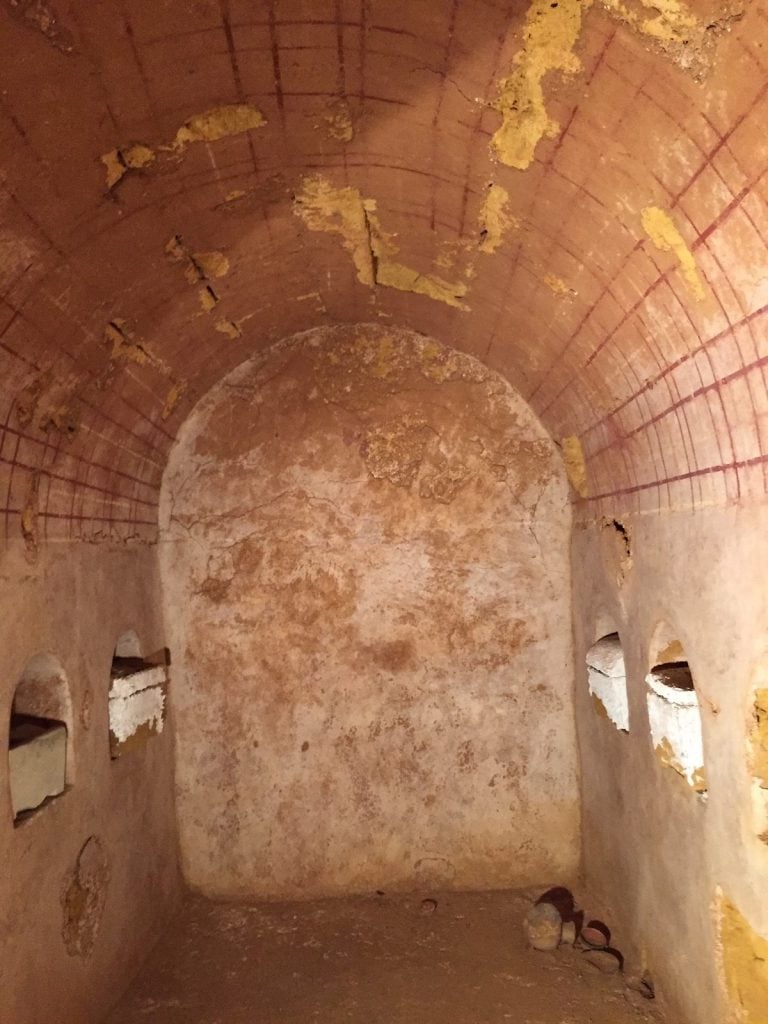
26 Jun Get Ready for a Corker! The World’s Oldest Known Wine
Source Credit: Content and images from Artnet News. Read the original article - https://news.artnet.com/art-world/oldest-known-wine-2504675
A Roman tomb dating back two millennia has offered a tantalizing find: the world’s oldest known surviving wine. The tomb, in the town of Carmona, in the province of Seville, was discovered in 2019 during renovation work on a private home. It contained the remains of six people, likely from the same wealthy family. It dates to the first century C.E., and was the eternal home of six people, four unnamed but two who were called Hispana and Senicio.
Previously, the oldest wine discovered was the Speyer wine bottle, discovered in 1867 in the eponymous German city. It dates to the 4th century and resides in the Historical Museum of Pfalz, in Germany.
In the Carmona tomb, a glass urn in the olla ossuria (jar and lid) format, with M-shaped handles, contained a reddish liquid. It would make sense for the liquid to be wine, since wine had religious significance, was highly symbolic, and was closely related to burial rituals.
“At first, we were very surprised that liquid was preserved in one of the funerary urns,” explained the City of Carmona’s municipal archaeologist, Juan Manuel Román, but since the tomb has been fully sealed since the burial ceremony, the team ruled out other sources of the liquid, such as floods, leaks, and condensation.

The Roman mausoleum. Courtesy Juan Manuel Román.
The challenge was to be certain that the liquid was wine, as they suspected it was. So, a team led by José Rafael Ruiz Arrebola from the department of organic chemistry at the University of Cordoba ran the liquid through a series of chemical analyses, studying characteristics such as its pH, the absence of organic matter, the mineral salts it contained, and the presence of certain chemical compounds that could be related to the glass of the urn or the bones of the deceased contained therein.
Essential to identifying the liquid was the presence of biomarkers known as polyphenols that appear in all wines. These were identified with the use of high-performance liquid chromatography-mass spectrometry (HPLC-MS). Seven polyphenols present in the Montilla-Moriles, Jerez, and Sanlúcar wines of today showed up in small quantities, confirming that the liquid was vino.
The absence of another one, syringic acid, suggests that the wine was white, not red, even though it has acquired a reddish hue over the centuries. On the other hand, said the paper, the syringic acid could have degraded over time. However, the mineral salts in the wine, identified using inductively coupled plasma mass spectrometry (ICP-MS), do match those in white wines currently produced in the region.
The same tomb has offered up other historic finds: last year, some of the same experts published a paper indicating that they had discovered patchouli-like Roman perfume there, in what they say is possibly the first discovery of its kind.
The team published these results in Journal of Archaeological Science: Reports.
Follow Artnet News on Facebook:
Want to stay ahead of the art world? Subscribe to our newsletter to get the breaking news, eye-opening interviews, and incisive critical takes that drive the conversation forward.
Source Credit: Content and images from Artnet News. Read the original article - https://news.artnet.com/art-world/oldest-known-wine-2504675

